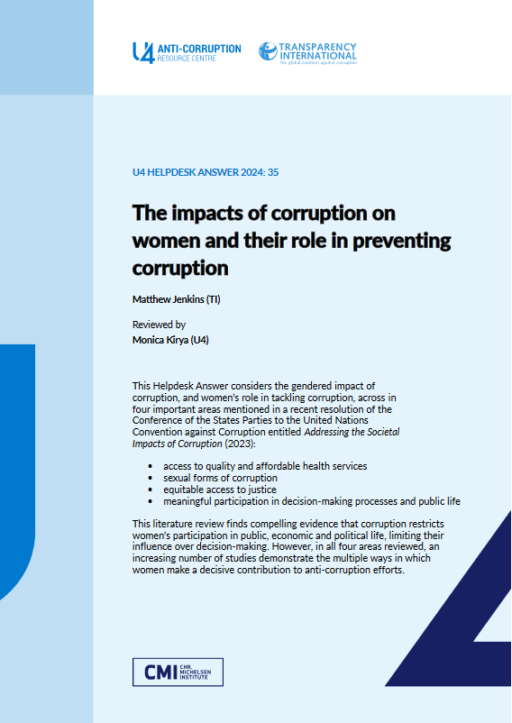- Home
- Anti-Corruption Helpdesk
- The impacts of corruption on women and their role in preventing corruption
The impacts of corruption on women and their role in preventing corruption

This Anti-Corruption Helpdesk brief was produced in response to a query from a U4 Partner Agency. The U4 Helpdesk is operated by Transparency International in collaboration with the U4 Anti-Corruption Resource Centre based at the Chr. Michelsen Institute.
Query
Please provide an overview of the gendered impacts of corruption and women’s role in preventing corruption.
Summary
This Helpdesk Answer considers the gendered impact of corruption, and women’s role in tackling corruption, across in four important areas mentioned in a recent resolution of the Conference of the States Parties to the United Nations Convention against Corruption entitled Addressing the Societal Impacts of Corruption (2023):
- access to quality and affordable health services
- sexual forms of corruption
- equitable access to justice
- meaningful participation in decision-making processes and public life
This literature review finds compelling evidence that corruption restricts women’s participation in public, economic and political life, limiting their influence over decision-making. However, in all four areas reviewed, an increasing number of studies demonstrate the multiple ways in which women make a decisive contribution to anti-corruption efforts.
Main points
- Gendered norms matter in terms of women’s lived experience of corruption when accessing public services. Corruption hinders women’s access to quality health services, upon which women tend to have a greater reliance due to a combination of social norms and their reproductive health-care needs.
- The most noticeable effects of corruption on women typically occur at the point of service delivery, where service providers and users interact, and extortive demands for bribes or others illicit acts are made. Nonetheless, less visible forms of corruption by mid-level administrators and senior officials can have equally pernicious effects on women’s access to health care.
- Material gender inequities, such as the fact that women generally possess fewer – or have less control over – financial assets can leave them less able to pay material bribes. In the last twenty years, research has uncovered how corrupt individuals in positions of authority extort sexual acts in return for goods or services to which the targeted person is entitled, a phenomenon commonly referred to as ‘sextortion’.
- Recent work by Bjarnegård et al. (2024a) has sought to broaden the understanding of sexual corruption beyond a narrow view of ‘sextortion’ to also encompass situations in which people with entrusted authority request or accept sexual acts in exchange for providing unwarranted privileges.
- Attempts to gauge the scale of sexual corruption through representative surveys have revealed it to be a widespread practice around the world.
- Where paying bribes to judicial or administrative staff becomes a prerequisite to access the court system, women’s relatively weaker access to and control over financial resources means they are more frequently denied justice than men. Gender inequality can be particularly stark when legal proceedings relate to property, while corruption in formal justice institutions can drive women towards informal justice mechanisms.
- Despite suffering disproportionately from the gendered impact of corruption, emerging data indicates that women appear to be less likely than men to report corruption. Gender inequalities likely explain this phenomenon, including the well-founded perception of gender bias in the processing of corruption cases, women’s lack of financial resources, and their greater anxiety of reprisals and re-victimisation.
- In systems in which political recruitment is not controlled through male-dominated patronage-based systems, women are more likely to enter elected office. Once there, there is strong empirical evidence that women have incentives and the ability to disrupt networks that perpetuate political corruption.
- While a higher proportion of women in elected office is correlated with lower levels of corruption, there are competing theories as to why this happens, including their marginalisation from male-dominated elite networks and their greater concern for well-functioning public service delivery.
Contents
- Impact of corruption on girls’ and women’s ability to access quality and affordable health services
- Sexual corruption
- Impact of corruption on women’s access to justice
- Women’s participation in policy-making and government
- References
Caveat
Corruption has a vast and complex range of effects on women across different sectors, locations, age brackets, and other variables. As such, a comprehensive assessment of the impact of corruption on women and their potential anti-corruption roles is beyond the scope of this Helpdesk Answer.
Instead, the paper limits itself to consideration of the gendered impact of corruption in four important areas explicitly mentioned in a recent resolution of the Conference of the States Parties to the United Nations Convention against Corruption entitled Addressing the Societal Impacts of Corruption (2023):
- access to quality and affordable health services
- sexual forms of corruption
- equitable access to justice
- meaningful participation in decision-making processes and public life
In addition, this Helpdesk Answer recognises the contribution of the comprehensive 2020 UNODC study, Time is Now: Addressing the Gender Dimensions of Corruption. As such, it prioritises an assessment of the literature published since 2020 in those four areas, to avoid duplicating existing material.
The Helpdesk Answer draws on previous publications by the same author (Bullock and Jenkins 2020; McDonald and Jenkins 2021).
Translations
This Helpdesk Answer is available in both Spanish and French (see Additional Downloads on the right of the page).
Authors
Matthew Jenkins, [email protected]
Reviewer
Monica Kirya (U4)
Date
02/09/2024
Tags
 Download PDF
Download PDF
